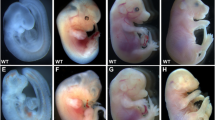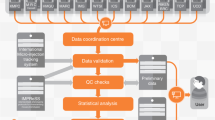Abstract
In the mouse, only a few genes have been definitively associated with a small-eye phenotype; the paired-box gene Pax6 and the gene coding for the microphthalmia-associated transcription factor (Mitf). Mutant alleles were recovered by crude phenotype screens and their effects on eye size are relatively large. This feature points to a bias during screening for eye-size mutants, selecting preferentially more severe phenotypes. An unbiased method determining eye-size parameters in an observer-independent, quantitative manner is expected to pick up variations in other genes, which will be confirmed as pathologic mutations in confirmation crosses. The present study used optical low coherent interferometry (OLCI) to compare the axial eye length, the cornea and lens thicknesses, and the anterior chamber depth in four common wild-type, laboratory inbred strains (C57BL/6J, C3HeB/FeJ, 129S2/SvPasCrl, and BALB/cByJ) between 4 and 15 weeks of age. There were no differences between left and right eyes; differences between the size parameters of males and females have been observed only in a few cases. An optimal screening age for OLCI measurements was defined as 11 weeks of age. At this age, we checked two other inbred strains (AKR/J and DBA/2NCrl) as well as CD-1 outbred mice. CD-1 mice have the largest axial length. The most impressive differences among inbred strains were, first, the anterior chamber depth, where the DBA mice have significantly lower values than the other strains. Second, the cornea in C3H mice is approximately 20% thicker than in the other inbred strains. Finally, wild-type intervals (mean ± 3 SD) for axial length, anterior chamber depth, and cornea and lens thicknesses were calculated allowing a quick identification of pathologic outliers.



Similar content being viewed by others
References
Anderson MG, Smith RS, Gawes NL, Zabaleta A, Chang B, et al. (2002) Mutations in genes encoding melanosomal proteins cause pigmentary glaucoma in DBA/2J mice. Nat Genet 30, 81–85
Balkema GW, Mangini NJ, Pinto LH, Vanable JW Jr (1984) Visually evoked eye movements in mouse mutants and inbred strains. Invest Ophthalmol Vis Sci 25, 795–800
Bogue MA, Grubb SC (2004) The mouse phenome project. Genetica 122, 71–74
Brown SDM, Chambon P, Hrabé de Angelis M for the EUMORPHIA Consortium (2005) EMPReSS: standardized phenotype screens for functional annotation of the mouse genome. Nat Genet 37, 1155
Dalke C, Graw J (2005) Mouse mutants as models for congenital retinal disorders. Exp Eye Res 81, 503–512
Dalke C, Löster J, Fuchs H, Gailuis-Durner V, Soewarto D, et al. (2004) Electroretinography as a screening method for mutations causing retinal dysfunction in mice. Invest Ophthalmol Vis Sci 45, 601–609
Dalke C, Puk O, Neuhäuser–Klaus A, Favor J, Graw J (2006) Eye Disorders. In: Phenotyping Standards of Mouse Models, Hrabé de Angelis M, Chambon P, Brown S (eds.) (Weinheim: Wiley VCH), pp 283–309
Douglas RM, Alam NM, Silver BD, McGill TJ, Tschetter WW, et al. (2005) Independent visual threshold measurements in the two eyes of freely moving rats and mice using a virtual-reality optokinetic system. Vis Neurosci 22, 677–684
Ehling UH, Charles DJ, Favor J, Graw J, Kratochvilova J, et al. (1985) Induction of gene mutations in mice: the multiple endpoint approach. Mutat Res 150, 393–401
Favor J, Peters H, Hermann T, Schmahl W, Chatterjee B, et al. (2001) Molecular characterization of Pax6 2Neu through Pax6 10Neu: an extension of the Pax6 allelic series and the identification of two possible hypomorph alleles in the mouse Mus musculus. Genetics 159, 1689–1700
Gould DB, Smith RS, John SWM (2004) Anterior segment development relevant to glaucoma. Int J Dev Biol 48, 1015–1029
Graw J, Löster J (2004) Congenital hereditary cataracts. Int J Dev Biol 48:1031–1044
Graw J, Löster J, Puk O, Münster D, Haubst N, et al. (2005) Three novel Pax6 alleles in the mouse leading to the same small-eye phenotype caused by different consequences at target promoters. Invest Ophthalmol Vis Sci 46, 4671–4683
Grubb SC, Churchill GA, Bogue MA (2004) A collaborative database of inbred mouse strain characteristics. Bioinformatics 20, 2857–2859
Hansdottir AG, Palsdottir K, Favor J, Neuhäuser-Klaus A, Fuchs H, et al. (2004) The novel mouse microphthalmia mutations Mitf mi-enu5 and Mitf mi-bcc2 produce dominant negative Mitf proteins. Genomics 83, 932–935
Hill RE, Favor J, Hogan BLM, Ton CCT, Saunders GF, et al. (1991) Mouse Small eye results from mutations in a paired-like homeobox containing gene. Nature 400, 522–525
Hrabé de Angelis M, Balling R (1998) Large scale ENU screens in the mouse: genetics meets genomics. Mutat Res 400, 25–32
John SWM, Smith RS, Savinova OV, Hawes NL, Chang B, et al. (1998) Essential iris atrophy, pigment dispersion, and glaucoma in DBA/2J mice. Invest Ophthalmol Vis Sci 39, 951–962
Lowry RB, Kohut R, Sibbald B, Rouleau J (2004) Anopthalmia and microphthalmia in the Alberta Congenital Anomalies Surveillance System. Can J Ophthalmol 40, 38–44
Lyon MF, Bogani D, Boyd Y, Guillot P, Favor J (2000) Further genetic analysis of two autosomal dominant mouse eye defects, Ccw and Pax6 coop. Mol Vis 6, 199–203
Michaud EJ, Culiat CT, Klebig ML, Barker PE, Cain KT, et al. (2005) Efficient gene-driven germ-line point mutagenesis in C57BL/6J mice. BMC Genomics 6, 164
Pinto LH, Enroth-Cugell C (2000) Tests of the mouse visual system. Mamm Genome 11, 531–536
Schmucker C, Schaeffel F (2004) In vivo biometry in the mouse eye with low coherence interferometry. Vision Res 44, 2445–2456
Stahl JS (2004) Eye movements of the murine P/Q calcium, channel mutant rocker, and the impact of aging. J Neurophysiol 91, 2066–2078
Steingrimson E, Moore KJ, Lamoreux ML, Ferré-d’amaré AR, Burley SK, et al. (1994) Molecular basis of mouse microphthalmia (mi) mutations helps explain their developmental and phenotypic consequences. Nat Genet 8, 256–263
Strom RC, Williams RW (1998) Cell production and cell death in the generation of variation in neuron number. J Neurosci 18, 9948–9953
Thaung C, Arnold K, Jackson IJ, Coffey PJ (2002a) Presence of visual head tracking differentiates normal sighted from retinal degenerate mice. Neurosci Lett 325, 21–24
Thaung C, West K, Clark BJ, McKie L, Morgan JE, et al. (2002b) Novel ENU-induced eye mutations in the mouse: models for human eye disease. Hum Mol Genet 11, 755–767
Acknowledgments
The work was supported in part by the German National Genome Network (NGFN; 01GR0103) and performed within the European framework on mouse phenotyping (EUMORPHIA; http://www. eumorphia.org). The authors thank Klara Fizi and Mareike Maurer for expert technical assistance and also Wilfried Bissmann (Carl-Zeiss Meditec, Jena, Germany) for the adaptation of the ACMaster software to the mouse eye dimensions.
Author information
Authors and Affiliations
Corresponding author
Rights and permissions
About this article
Cite this article
Puk, O., Dalke, C., Favor, J. et al. Variations of eye size parameters among different strains of mice. Mamm Genome 17, 851–857 (2006). https://doi.org/10.1007/s00335-006-0019-5
Received:
Accepted:
Published:
Issue Date:
DOI: https://doi.org/10.1007/s00335-006-0019-5




